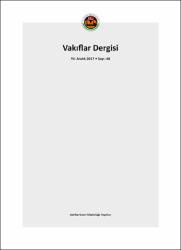| dc.contributor.author | Çalık, Sıddık | |
| dc.date.accessioned | 2018-01-31T07:56:43Z | |
| dc.date.available | 2018-01-31T07:56:43Z | |
| dc.date.issued | 2017-12 | |
| dc.identifier.citation | ÇALIK, Sıddık. "Amasya kazası’nda Seydi Çelebi ve Mehmed Çelebi’ye ait H. 790/ M. 1388 tarihli türkçe vakfiye." Vakıflar Dergisi, 48 (2017): 9-16. | en_US |
| dc.identifier.uri | http://dergipark.gov.tr/uploads/issuefiles/4dc1/312a/b29c/5a4e0c0ec44f7.pdf | |
| dc.identifier.uri | https://hdl.handle.net/11352/2662 | |
| dc.description.abstract | Üzerinde çalıştığımız vakfiye, Kadı Burhaneddin devletinin sonlarına tekabül eden döneme aittir. Vakfiye
Hicrî 790 /Miladî 1388 tarihli olup, bazı hususiyetleriyle önemi hâiz bir belge niteliğindedir. Her
şeyden önce, vakfiyeyi, eski tarihli ve sayıları oldukça az olan orijinal vakfiyeler içerisine dahil edebiliriz.
Keza belgenin dili Türkçedir. Bu hususiyeti, onun çok nadir bir eser olduğunu gösterecek niteliktedir.
Hatta bu belgeye, yukarıda vakfiyelerin dili ile ilgili mütalaalarımızı dikkate alırsak, ilk Türkçe vakfiye
diyebiliriz. Belge tam manasıyla dönemin dilini ve yazı tarzını yansıtmaktadır. Fizikî özelliklerinden de
anlaşıldığı kadarıyla vakfiye, 14. yüzyıla aittir. Vakfiyede, vakf edilen yerlerin malikâne olması, dönemin
toprak tasarruf hususiyetinin ipuçlarını yansıtmaktadır. XIV. Yüz yıl Anadolusu’nun toprak rejimine baktığımızda
elimizdeki vesikanın, dönemin sosyo-ekonomik yapısına nasıl ışık tuttuğunu anlamış olacağız. | en_US |
| dc.description.abstract | This waqf deed that I studied upon belongs to the Kadi Burhaneddin’s State’s last period. The date of
waqf deed is 1388, and the document is very crucial with some aspects. First and foremost, this waqf
deed is one of the old-dated and rare original waqf deeds. In this respect, the language of the document
is Turkish. This aspect shows that this waqf deed is a rare document. Even considering our comments
on the language of waqf deeds we can say that this is the first waqf deed in Turkish. Document
reflects the language and the writing style of that period. By looking at the physical characteristic of
the document, we can claim that it belongs to the 14th century. The lands were recorded as malikane
in waqf deed and this gives us clues on land tenure system of that term. When we look at the land
regime of 14th century Anatolia, we will understand how this waqf deed in question sheds light on the
socio-economic structure of the period. | en_US |
| dc.language.iso | tur | en_US |
| dc.publisher | Vakıflar Genel Müdürlüğü | en_US |
| dc.rights | info:eu-repo/semantics/openAccess | en_US |
| dc.subject | Vakfiye | en_US |
| dc.subject | Kadı Burhaneddin Devleti | en_US |
| dc.subject | Malikâne | en_US |
| dc.subject | İkta | en_US |
| dc.subject | Beylikler Dönemi | en_US |
| dc.subject | Waqf deed | en_US |
| dc.subject | Kadı Burhaneddin State | en_US |
| dc.subject | Malikane | en_US |
| dc.subject | Ikta | en_US |
| dc.subject | Period of Principality | en_US |
| dc.title | Amasya kazası’nda Seydi Çelebi ve Mehmed Çelebi’ye ait H. 790/ M. 1388 tarihli türkçe vakfiye | en_US |
| dc.title.alternative | Turkish waqf deed that belongs to Seydi Çelebi and Mehmed Çelebi in district of Amasya dated H. 790/ M. 1388 | en_US |
| dc.type | article | en_US |
| dc.contributor.department | Vakıflar Genel Müdürlüğü Yayınları | en_US |
| dc.relation.publicationcategory | Makale - Ulusal Hakemli Dergi - Başka Kurum Yazarı | en_US |



















